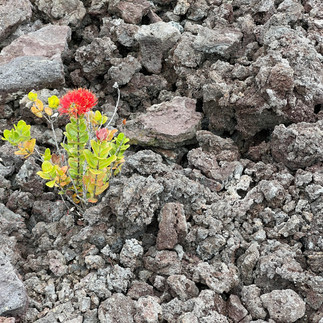
When I think of Hawaii, my first thought is not a landscape that is dry, crunchy and black or has a park with a trail named “devastation” and smells like sulfur. I usually delight in ocean waves, coconutty umbrella drinks and palm trees swaying in a light breeze. But when I reflect on our Big Island Hawaii trip, visiting Volcano National Park was one of my favorite things we did.
Volcano National Park (VNP) is part of the United States’ National Park system and includes two of the world’s most active volcanoes, Kilauea and Mauna Loa. It’s a massive park of more than 500 square miles, and you definitely need a car to explore it. At one end of the park it’s sea level and at the highest peak of Mauna Loa it’s nearly 14,000 feet.
Hawaii was created by volcanic activity. When you stay in a resort area, that can be easy to forget when you’re surrounded by sand, tourists and shopping. Once you visit Volcano National Park, you won’t forget for the rest of your vacation (or ever) that you were literally sleeping on a volcano during your Hawaii visit. While we did not see any lava flowing, there were heightened earthquake activity reports shortly after our trip, which could’ve indicated volcanic activity around the corner. Big Islanders live with this reality every day.
We dedicated two days to explore the park and spent the night in the town of Volcano so we could maximize our time. The drive from Puako Beach to VNP was about two hours.
My husband loves visiting national parks so I entrusted his careful research and planning for what we should see.

We couldn’t cover the entire park in two short days, so we focused in on these Volcano National Park highlights:
Steam Vents
Ranger led hike across Kilauea-Iki Trail (including walking across a lava field)
Lava Tube
Devastation Trail
Pu’uloa Petroglyph Hike
Chain of Craters drive
Sea Arch viewing (and windiest picnic I’ve ever attempted)
Our first stop at VNP was the Visitor’s Center where there was a list of free ranger-led tour offerings for the day.
Knowing we had a few hours before our chosen tour, we drove to the steam vents and wandered around, taking in the magnitude of this huge park. We packed a picnic lunch to fortify ourselves before the three hour hike. Once you are inside the park, there are no food vendors, snack machines or anything to eat or drink (other than a water bottle fill station).

STEAM VENTS
The Crater Rim Trail offered an easy walk with expansive views of the Steaming Bluff Overlook. The names are self-explanatory, but the size of this place is hard to describe. The steam is created by groundwater or moisture in the air falling into crevices and hitting the rocks that are still hot from magma beneath. Yes, it’s that hot underneath!

RANGER LED KILAUEA-IKI TRAIL
Our tour of the Kilauea-Iki Trail was led by Robyn, a dedicated VNP volunteer ranger from Germany. She volunteers in exchange for food and lodging at VNP and is extremely knowledgeable. During our three hours together, Robyn took us up hilly trails and then we descended down into lush rainforest leading to a bleak field of solidified lava, raised and broken in places, humped in mounds and swirls that looked like hardened chocolate soft-serve ice cream. During educational rest stops, she explained the parts of a volcano and how it is formed, using her arms and torso as a demonstration map. Her scientific lecture was much more interesting through her stories, which kept the teens in our tour group listening intently. Robyn also told us the legendary stories of Madame Pele, the Hawaiian goddess of volcanoes and fire, and how Pele is thought to reside in VNP at the summit of Kilauea. We were warned to respect Pele and to avoid bad luck we should not take any volcanic rock home as a souvenir.
After we made it across the solidified lava lake, we hiked straight up as a misty rain started, making everything a little more slippery and treacherous.
The 3.5-mile hike was strenuous, even with clear pathways and a guide who was willing to stop and wait for stragglers. The climate continually changed, causing me to put on my raincoat, then sweat and steam and take off my coat…but I was glad to have options. We were lucky to have a slightly overcast and rainy day to beat the heat and skip the sunscreen.
Robyn’s explanation of how the top crust of the lava field covered the liquid magma somewhere underneath made me think of my favorite kind of brownie (or lava cake)—a top shiny crust, breaking in places where the goo was liquid beneath. But maybe that was because I was hungry from the hike?
She also had our group mesmerized with her tale of waking up in her cabin on the park grounds to a shaking earthquake. Instead of running for her life, she and the other rangers and scientists all gathered outside at 4 a.m. waiting to see if lava would come spraying out of the volcano.

LAVA TUBE
A lava tube is created when a river of lava once flowed. Now, hundreds of years later, you can walk through the wet, drippy cave path, which is surrounded by lush, tropical, jungle-like tropical rainforest. This is a popular stop for visitors yet it has the smallest parking lot. We couldn’t get in on our first attempt (in the afternoon after our hike), but it was easy early the next morning and we had the tube nearly to ourselves (around 9 a.m.).
While we missed the drama of a night viewing (flashlights only), it is still pretty dramatic to walk inside a giant tube that was created by flowing lava! We first experienced lava tubes in Iceland and wanted to make sure we got to see a Hawaiian one.

DEVASTATION TRAIL
A walk along the Devastation Trail illustrates a landscape still not quite recovered from the 1959 Kilauea Iki eruption. The hills are covered with cinders and volcanic ash. The walk is an easy paved path and it was interesting to see the juxtaposition of a pretty park of emerging greenery and flowers next to a stark black hill of cinders.
PU’ULOA PETROGLYPHS
Native Hawaiians carved drawings into hardened lava, telling their stories through symbols. The field of petroglyphs was interesting, with human forms, turtles and what looked a lot like the Target logo. I was fascinated by a range of dots. Each dot was where a family buried an umbilical cord as it was thought to insure a long life for their child.
This hike was hot and incredibly windy but very much worth the mile and a half trek into the field and back. It was hard for me, usually coated in SPF 50, to imagine living in this brutal sun, howling wind and ever-present threat of a volcano about to blow.
Sections of the road near the Hōlei Sea Arch are permanently closed as they were covered in lava during the eruptions a few years ago. The Sea Arch looks a little bit like a leg and is in danger of collapsing due to the exposure to the beating waves and heavy winds.
HOLEI SEA ARCH
(windiest picnic ever attempted)
For something entirely different, we drove many miles to the end of the park where you can see where the trails of lava flowed directly into the ocean. In the ocean, you will see an arch of lava that resembles a leg or an elephant’s trunk. It was believed to be formed 550 years ago. We drove to this area and it was amazing to see the long runs where lava flowed from the volcano, all the way down the mountain and into the sea. The continuous pounding of the ocean and the whipping wind lead geologists to predict the Sea Arch may not have many more years left before the elements claim it.
The view from this area is rugged and beautiful and wildly windy. We brought a picnic lunch and the only possible place to eat it was the picnic table wedged between two buildings to cut the wind. Even then, we were holding down chips and sandwiches ready to take flight (hint: don’t plan your picnic here).
STAYING (AND EATING WELL) IN VOLCANO, HAWAII
Photos, top row: Lilikoi lemon haupia pie, Macadamia crusted ono with roasted cauliflower
Second row: Mai Tai with ube foam, the Kilauea Lodge "Fireplace of Friendship" with inset coins from all over the world, Pele's Punch (known for the power to forget your hiking aches)
After a day of hiking, we were so glad we rented a house nearby and did not have to drive two hours back to where we were staying on the Kona side of the island. After cleaning up, we headed to dinner at the Kilauea Lodge, a hotel fashioned from a former YMCA lodge. Its 1930s rustic vibe kept us in the national park mood and the Pele’s Punch took the edge off my sore muscles. Their menu had wonderful options including catch of the day (macadamia crusted Ono served with sauteed cauliflower, raisins, capers and macadamia nuts) and a grilled ribeye with Hamakua mushrooms and garlic herb butter. Our rental house guidebook told us not to miss their “deserts,” so we indulged in a lilikoi lemon haupia pie for a sweet ending to our exhausting and exhilarating day.
I loved our visit to Volcano and VNP. I’ll never forget that beneath my feet, below the dark crunchy landscape lurked Madame Pele and the ever-present potential for change.
_____________________
Plan your visit by getting the most accurate and recent conditions here: Alerts & Conditions - Hawaiʻi Volcanoes National Park (U.S. National Park Service) (nps.gov)























































コメント